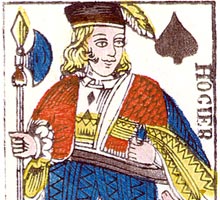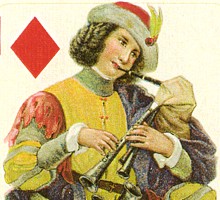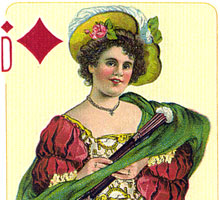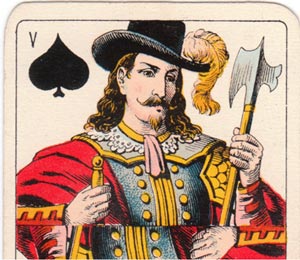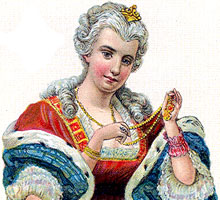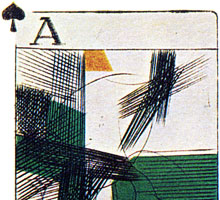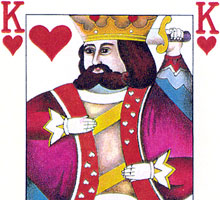Swiss Playing Cards
The Swiss national suit system of shields, acorns, hawk bells and flowers emerged sometime during the XV century.
Playing Cards from Switzerland
Although playing cards may have first appeared in Italy or Spain, they very soon arrived north of the Alps. Alongside the printing of textiles, the humble woodblock prints of saints and playing cards were forerunners in the art of printing. Early literary evidence indicates that playing cards arrived in Switzerland sometime around 1376. In 1377 A friar from Basle by the name of John described a pack of cards [‘Ludus Cartarum’] in some detail during a sermon, and a great freedom was already apparent in the composition of the pack described by him. Brother John explained that cards were painted and played with in different manners. He also added that the new game was of advantage to noblemen and to others, especially if they practise it courteously and without money. We know from prohibitions that gambling caused concern to the authorities who sought to ban or regulate it because it attracted gamblers and cheats.
Brother John went on to say that there are four Kings depicted on four cards, and each one holds a certain sign in his hand and sits upon a royal throne, and under the King are two “marechali,” the first of whom holds the sign upright in his hand, and the other holds the sign downward in his hand.
The Swiss national suit system of shields, acorns, hawkbells and flowers emerged sometime during the fifteenth century from a multiplicity of suits which had evolved in the Upper Rhine region. A common feature of many of these early cards is that the Kings are seated on thrones while the upper and lower valets are standing, often holding their suit sign. Another feature is the ‘banner 10’ which was found in packs throughout the South of Germany and especially around the Alps in the 15th and 16th centuries. The banner 10 now only survives in Swiss playing cards and is more or less counted as an Ace.
An edict from Lyons in 1583 caused many French playing card makers to emigrate to Switzerland because of excessive duty on playing cards. And as new cantons joined the ancient Swiss Confederation they brought with them the customs of other lands: Italian-suited tarot cards and French-suited cards in the Paris and Lyons styles.
Switzerland of the Helvetic Republic (1798-1803) levied a tax on playing cards that applied nationwide. Interestingly, the proceeds from fines for violations were designated for charity. An ordinance of February 10, 1801, stated that fines for violations of these levies in equal parts would be deposited: one-sixth with the informant, one-sixth with the municipality where the abuse was reported, and the last sixth went to the poor of the same locality.
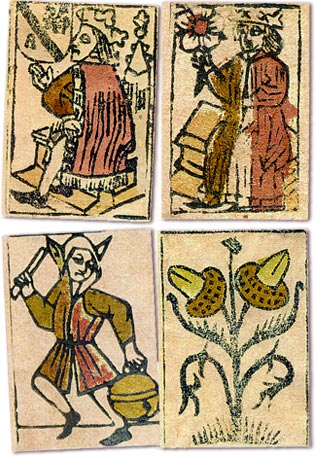
Above: early 16th Century Swiss playing cards produced by woodblock and stencil printing. The acorns seem to be growing on stems, unlike anything seen in nature. see more →
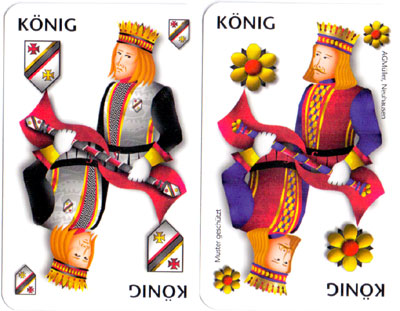
Above: Modern Swiss-German Pattern with 3D computer effects, AGMüller, c.2000. see more →
AGM Müller 
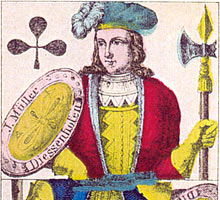
Above: XP5 French Style, c.1840s
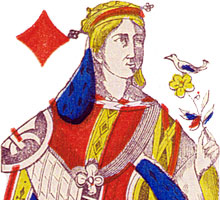
Above: French style Piquet deck, c.1850

Above: Swiss Costumes, c.1890

Above: Müller Moguls, c.1890
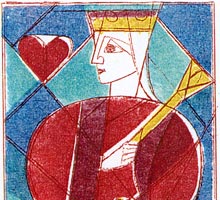
Above: Gertrude Kümpel, 1989
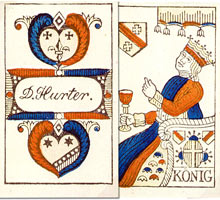
Above: David Hurter, c.1830s
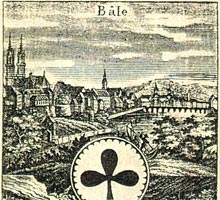
Above: Scenic Aces, J. Müller, c.1850

Above: Scenic Aces, J. Müller, c.1860

Above: Müller Spanish pack, c.1875

Above: Madame Lenormand

The distinguished firm AG Müller was founded in 1828 by Colonel Johann Bernhard Zündel (1791-1863) who opened a playing card workshop in partnership with the cardmaker Fizell, and in 1830 he employed Johannes Müller (1813-1873) for a four year apprenticeship. In 1831 Johann Georg Rauch (1789-1851) took over Zündel's factory and the business was relocated to Diessenhofen. By 1835 Müller had been promoted to foreman, by which time the factory was employing six workers and producing about 3,000 dozen packs of playing cards a year. A few years later (1838) Johannes Müller was fortunate to be offered an opportunity to buy the business. In due course Müller introduced machinery to assist with the production and in 1855 Müller expanded his range of goods to include railway tickets to meet the growing demand from the new railway lines being built, which coincided with the rise in tourism.
In 1863 Müller was able to purchase David Hurter’s playing card factory which had existed in Schaffhausen since 1793. Müller's son, Johannes Müller Jnr (1837-1901), who held the post of works manager in the factory at Schaffhausen, married Hurter’s daughter Anna Margaretha in 1865. When his father died in 1873, Johannes Müller-Hurter decided to close the Diessenhofen workshop and relocate the business to Schaffhausen. At this time the enterprise was equipped with the most modern machines available, which enabled Müller to widen his playing card range to include souvenir packs and playing cards destined for export to continents such as India and South America.
In due course, after the successful acquisition of another rival playing card factory, more spacious premises were obtained in Neuhausen-on-Rhine Falls in 1898. In 1901 the management of the factory passed to Müller's youngest son, Heinrich Julius Müller (1875-1948), who expanded the business output up to 100,000 dozen packs of cards. This success was achieved by renewal of the machinery as well as H. J. Müller's commercial skills, inventive talent and improvement in the quality of all products. New machines allowed twelve-colour printing which in turn led to a wider range of playing cards. A price list from 1922 mentions over 50 different types of playing cards on offer.
In 1960 the playing card factory in Neuhausen became AGMüller (Aktiengesellschaft - Public Limited Company). The old factory building had already been upgraded in 1954 and additional new offices were also built. As a result of the emergence of the esoteric use of tarot cards, the playing card factory expanded to become one of the leading suppliers of Tarot cards worldwide, which were above all exported to the United States. Further new buildings were erected in 1974/75 for this purpose.
By 1982 the pressure of foreign competition in the playing card market was being felt and the family decided to sell the entire business to Biella-Neher in Biel. The new owners of AGMüller concentrated fully on playing card manufacture. Urania Verlags AG was founded in 1988, based in Neuhausen, which became a world leader in the field of tarot cards and associated esoteric literature. However in 1999 the playing card manufacturing subsidiary was sold to Carta Mundi SA in Turnhout (Belgium). AGMüller in Neuhausen continues to supply tarot cards worldwide, with a range of well over 120 titles growing each year.
Over the years many graphic artists have designed playing cards for, or been printed by, Müller & Cie, including Melchior Annen, Marianne Pomeroy, A. Sager, Fredy Prack & René Beuret, Elsi Jegen, Robert Hiltbrand, Susan Csomor, Fredy Sigg, Fritz Bünzli, Mario Grasso, Roland Gazzotti, Egbert Moehsnang and Gertrude Kümpel as well as many dozens of tarot artists.
REFERENCES
Cremers, Filip: Belasting is Troef, Nationaal Museum van de Speelkaart, Turnhout, 1992, p.109.
Ruh, Max & Rüegg, Max: AGM Müller: 175 Years of Playing Card Manufacture in "The Playing-Card" Vol.32 no.3, Nov-Dec 2003, IPCS, England.
Scotoni, Ralph: “Swiss Suited Playing Cards” on altacarta.com→
See also: Early Cards • 17th century Swiss-suited cards • David Hurter, 1830 • Johannes Müller, c.1840 • French Suited Cards, c.1840 • Scenic Aces 1850 • David Hurter, c.1860 • Scenic Aces 1860 • Modern Scenic Aces • Wüst Swiss Album Patience • Regional Costumes • Madame Lenormand • Spanish-suited c.1875 • ‘Moguls’, c.1890 • Spanish ‘Cádiz’ type • Schweizer Luxus-Jasskarte No.41 • Cartes au Boston No.48 • Humanist Bridge • Rococco • Patience No.98 • Richard Wagner • Casino • La Suisse Historique • Gold Medal Bridge Cards • Marguerite • Richelieu • Brunner Möbel • Zodiac Bridge • Swiss Tarot Cards • Abstract Bridge • Jass Allemand • Gertrude Kümpel, 1991 • Basler Fasnachts-Karten.

By Simon Wintle
Member since February 01, 1996
I am the founder of The World of Playing Cards (est. 1996), a website dedicated to the history, artistry and cultural significance of playing cards and tarot. Over the years I have researched various areas of the subject, acquired and traded collections and contributed as a committee member of the IPCS and graphics editor of The Playing-Card journal. Having lived in Chile, England, Wales, and now Spain, these experiences have shaped my work and passion for playing cards. Amongst my achievements is producing a limited-edition replica of a 17th-century English pack using woodblocks and stencils—a labour of love. Today, the World of Playing Cards is a global collaborative project, with my son Adam serving as the technical driving force behind its development. His innovative efforts have helped shape the site into the thriving hub it is today. You are warmly invited to become a contributor and share your enthusiasm.
Related Articles

Zürcher Festspiel 1903
Swiss-suited pack designed by Robert Hardmeyer featuring figures from art and politics.

The Tarot of Meditation – Yeager Tarot
Marty Yeager’s original Tarot of Meditation from 1975, republished later by U.S. Games Systems, Inc....

Modern Jass (Fredy Sigg)
Caricatural updating of traditional Swiss Jass cards by the artist Fredy Sigg.

Swiss playing cards by Iehan Hemau
17th century Swiss-suited playing cards by Iehan Hemau of Épinal.

Frauejass
‘Frauejass / le Jass au féminin’ designed by Susan Csomor, Switzerland, c. 1998.

Bourbon Bridge
Attractive, woodcut-style courts adapted for modern play.

Bischofszell
Advertising pack for the food producer Bischofszell, designed by Heinz Looser-Brenner, with non-stan...

Scheffmacher
Advertising pack for Scheffmacher, master painters in Schaffhausen, with comic designs by Fritz Bünz...

Portrait de Fribourg
Fine reproduction of a Fribourg pattern pack, originally by Jean-Jacques Burdel.

Tavaglione playing cards
Well-designed pack by Giorgio Tavaglione, with courts in medieval costume.

Swiss Scenic Tarock
Scenic Tarock deck produced by Fabrique de Cartes J. Müller & Cie (Schaffhouse), Suisse.

Vues et Caractères Suisses No.228
A Swiss souvenir pack by Dondorf

Schwyzer Fasnachts-Jass
Traditional carnival figures from the Swiss canton Schwyz, as interpreted by the artist Léon Schnyde...

Joker Tell
Comic celebration of 700 years of the Swiss Confederation, 1291-1991, with designs by Roland Gazzott...

Swiss Souvenir
55 different scenic photographic views of Switzerland.

Standard Swiss-German pattern (single-ended)
20th century version of a single-ended Swiss-German pattern pack for the game of Jass.
Most Popular
Our top articles from the past 28 days


